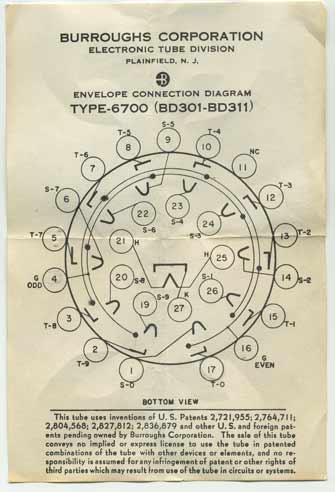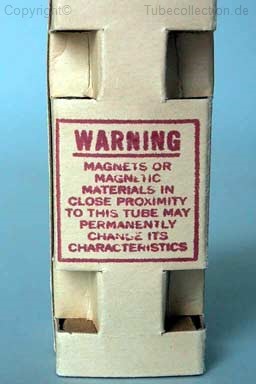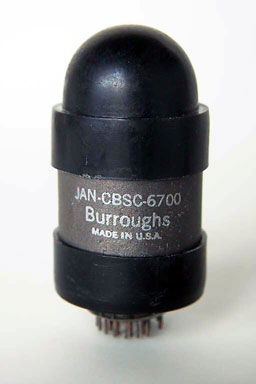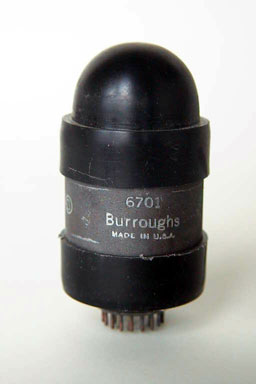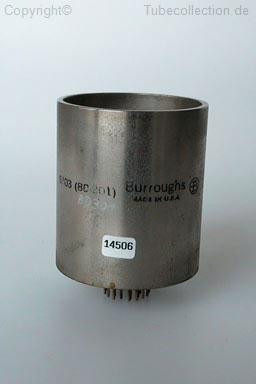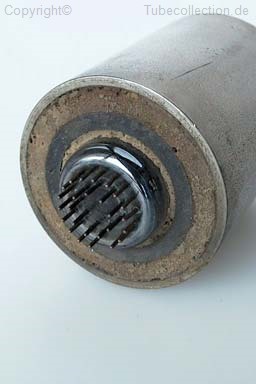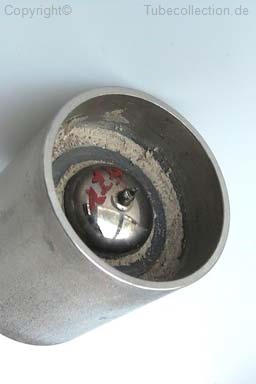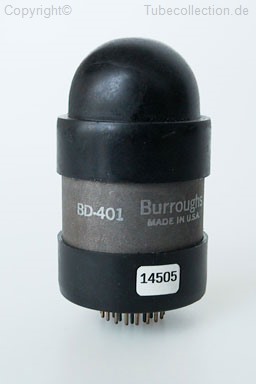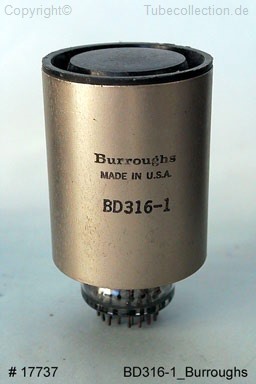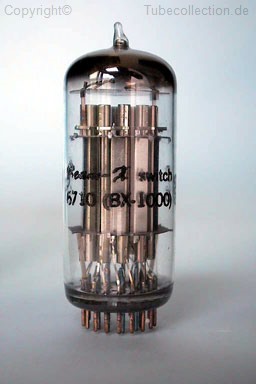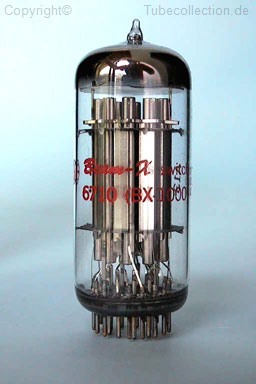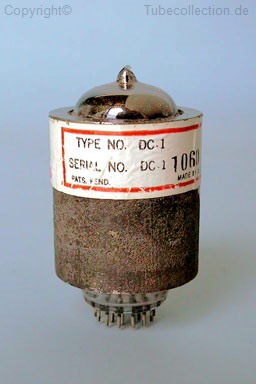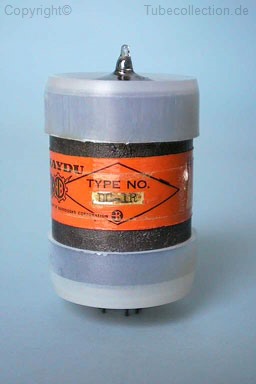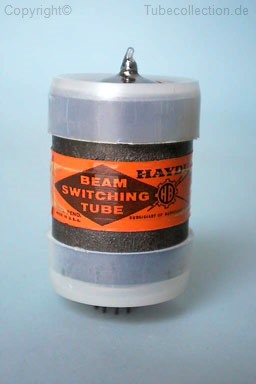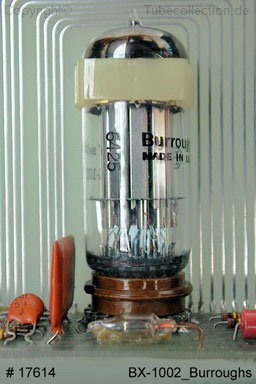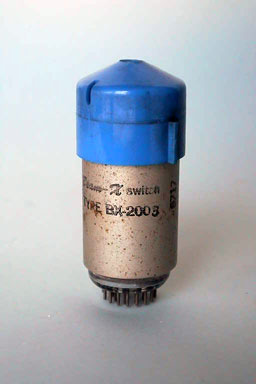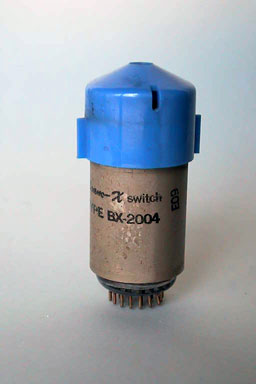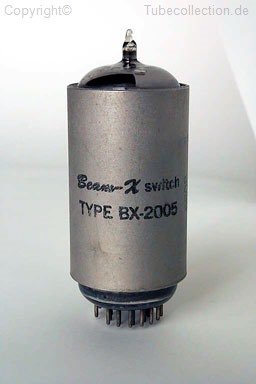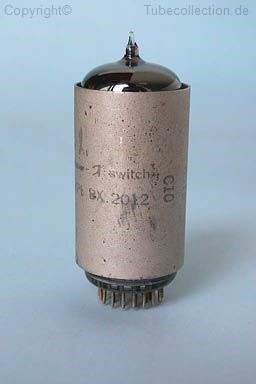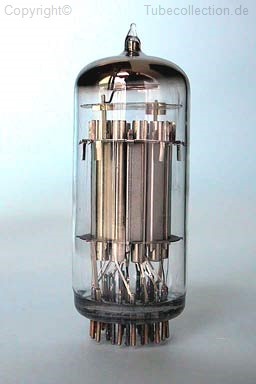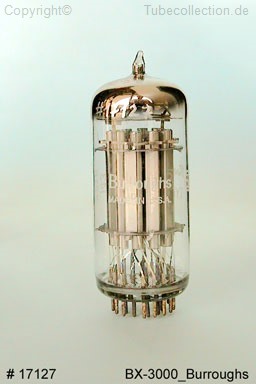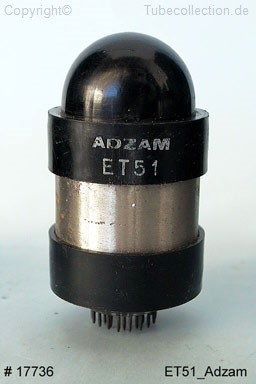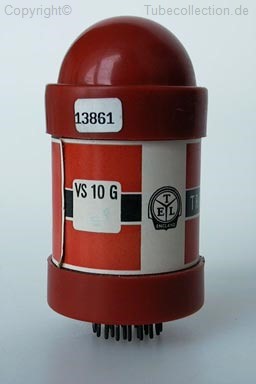 Magnetic beam switching tubes are exotic hard vacuum decimal counting
devices used in high speed applications through the 1950's and 1960's.
They feature counting speeds up to 10 MHz (versus 1 MHz for the fastest
dekatron) and high electrical efficiency. They also produce output signals
which can be coupled directly to a Nixie tube with minimal intermediate
components.
Magnetic beam switching tubes are exotic hard vacuum decimal counting
devices used in high speed applications through the 1950's and 1960's.
They feature counting speeds up to 10 MHz (versus 1 MHz for the fastest
dekatron) and high electrical efficiency. They also produce output signals
which can be coupled directly to a Nixie tube with minimal intermediate
components.
Like the Nixie tube, the magnetic beam switching tube was introduced by
Haydu Brothers. The magnetic beam switching tube was originally patented by Jerome
Lemelson, but given Lemelson’s long, well-established history of patent
abuse, it’s hard to say whether or not he actually invented the device,
or simply stole it from somebody else. The MBST patent was filed on
February 10, 1958, several years after Haydu began production.and developed into an extensive product line by Burroughs.
Several European companies also offered clones and near-clones of early
Haydu/Burroughs models, but Burroughs stood alone in innovation,
developing faster and more compact models over the span of only a few
years.
Standard Envelope
The 6700 and the 6701 are the earliest types
beeing manufactured in original style by the Haydu Brothers.
These early models have a large
cylindrical external magnet, plastic end caps, and no mu shield. Later on,
Burroughs introduced shielded variants of these large models, making the final package even larger
and more than twice as heavy. Some of the early models feature 'grid zero',
where grid even, position zero can be triggered separately for faster
resetting. In the standard pinout, pin 11 is unused. In the grid
zero pinout, grid zero is on pin 16, and the remainder of grid even is
moved to pin 11. Burroughs also manufactured 10 MHz standard envelope
models with internal spade resistors and an atypical 20-pin
base.
The 6700 and 6701 have the widest range of cosmetic variations of any
magnetic beam switching tube. The earliest 6700's were manufactured by
Haydu shortly after it was absorbed by Burroughs. Such tubes are branded
with the Haydu logo and have clear plastic end caps. Unlike later 6700's,
the Haydu 6700 does not have a domed top cap; instead, the top and bottom
caps are identical, both resembling the bottom caps found on all
variations. The Haydu 6700 has an orange plastic label wrapped around the
magnet, instead of bare iron like later Burroughs-manufactured variations.
The earliest Burroughs-branded 6700's and 6701's also have a label instead
of a stamp, but red with the Burroughs logo in black. This variation has a
black domed top cap, and a clear Haydu-style bottom cap. A slightly later
variation retains the red printed label, but has a different print
arrangement and black bottom cap like later bare iron variations. Bare
iron 6700 / 6701 variations all look fairly identical. They are available
with or without a bottom cap, and have black or silver print. There is
also a JAN variant of the 6700 which looks identical to a normal 6700, but
with the JAN part number prefix.
It should also be mentioned that at least one BD-301 print style includes
a 6700 dual part number. This is odd, because the electrical
characteristics of the 6700 and BD-301 are similar, but not identical.
First-generation beam switching tubes were large, heavy and expensive.
Burroughs responded to the size issue by engineering a reduction in
envelope and magnet size. The miniature envelope style has a primary
envelope diameter that is significantly smaller than the base of the
envelope, flaring outward just above the pins to accomodate the size of
the standard 26-pin base. Such tubes were also available in shielded
and unshielded varieties, the shielded types being of the same diameter as
a standard-size unshielded model.
Beam-X Switch
Reducing the envelope size was a a limited solution. The envelope could be
reduced no further, and the so-called miniature tubes were still fairly
large and fairly heavy, especially the more common shielded types. In
1960, Burroughs introduced a more radical solution. Instead of making the
envelope smaller, they returned it to its original larger size, large
enough to accomodate a new design with an even smaller spade cage and
internal magnets.
These advanced tubes, sold under the Beam-X Switch trademark, have 10
small internal magnets and add a signal-improving shield grid. Beam-X
Switch tubes are much smaller, lighter and faster than their
external-magnet predecessors: the unshielded BX-1000 and BX-3000 are the
smallest beam switching tubes ever produced, and are the size of a first
generation tube minus the magnet and shield. Shielded Beam-X tubes are
only slightly larger, and can be installed adjacently.
The is identical to the standard 25-pin configuration, but
adds the shield grid on pin 11. Like earlier models, Beam-X Switch tubes
were manufactured in both shielded and unshielded
types.
The BX-1000 has several internal variations, the most notable being the
enlargement of shield grid elements over the course of the tube's
manufacture. The earliest BX-1000's have a smaller shield grid, which does
not overlap the adjacent magnets to the same degree as in later examples.
These early tubes seem to date prior to 8/28/61, the date the tube
received its registered part number. All known examples with small shield
grids lack the 6710 part number on the external print, labeled as 'TYPE BX
1000'. Later examples with large shield grids are labeled as '6710
(BX-1000)'. It is currently unknown whether the larger shield grid offers
any improvement over the small shield grid, but later models of beam
switching tube (BX-1203, BX-3000) all have larger shield grid elements.
The BX-1000 evolved into a wide range of obscure, poorly documented
descendants, which leads us into a mix of known facts and speculation.
There are four series of BX tubes: BX-1000, BX-2000, BX-3000 and BX-4000.
BX-1000 and BX-2000 are identical, except the BX-2000 adds a mu shield. We
think it likely that the unshielded BX-3000 and shielded BX-4000 are
similarly related. Based on the part-numbering scheme, it's likely that
there was a significant performance increase between the BX-1000/2000 and
the BX-3000/4000. The most obvious performance improvement to prompt an
entire new part series would be a counting speed increase. The maximum
counting speed in a MBST is directly linked to the capacitance between the
spades and the spade lead resistors. We think it likely that the
BX-3000/4000 represents an improvement in spade lead capacitance, possibly
obtaining counting speeds as high as 10 MHz. Burroughs previously released
the 6700-variant MO-10R, which achieved its 10 MHz rating by internally
incorporating spade lead resistors at a minimal distance from the spades.
Though the BX-3000 does not appear to have internal resistors, it does
have internal dimensional changes as compared to the BX-1000.
It should be noted that the speeds listed for Beam-X tubes are their
maximum published specifications. Internal Burroughs documentation
directly states that the BX-1000 (and therefore the electrically identical
BX-2000 and BX-2012 as well) is capable of stable operation up to 3 MHz.
Other variants may be capable of higher-than-published counting speeds as
well.
